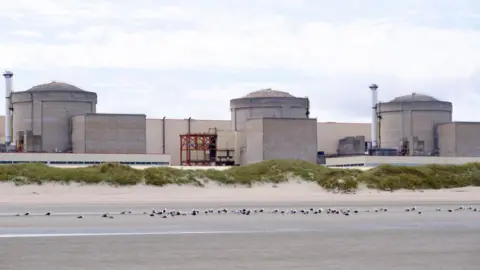 Getty Images
Getty ImagesA French nuclear plant temporarily shut down on Monday due to a “massive and unpredictable presence of jellyfish” in its filters, its operator said.
The swarm clogged up the cooling system and caused four units at the Gravelines nuclear power plant to automatically switch off, energy group EDF said.
The site in northern France was shut after the incident, with its remaining two units already down for maintenance.
EDF said there had been “no impact on the safety of the facilities, the safety of personnel, or the environment”.
It added that the fish were found “in the non-nuclear part of the facilities”.
“The plant teams are mobilised and are currently carrying out the necessary diagnostics and interventions to be able to restart the production units safely,” EDF said in a statement.
About 70% of France’s electricity comes from nuclear energy, according to the World Nuclear Association (WNA), and Gravelines is one of the country’s largest power plants.
Situated between Dunkirk and Calais, its six units each produce 900 megawatts of power.
It is cooled from a canal connected to the North Sea – where several species of jellyfish are native and can be seen around the coast when the waters are warm.
According to nuclear engineer Ronan Tanguy, the marine animals managed to slip through systems designed to keep them out because of their “gelatinous” bodies.
“They were able to evade the first set of filters then get caught in the secondary drum system,” he told the BBC.
Mr Tanguy, who works at the WNA, said this will have created a blockage which reduced the amount of water being drawn in, prompting the units to shut down automatically as a precaution.
He stressed that the incident was a “non-nuclear event” and more a “nuisance” for the on-site team to clean up.
For local people, there would be no impact on their safety or how much energy they could access: “They wouldn’t perceive it as any different to any other shut-down of the system for maintenance.”
Jellyfish have caused similar problems at power stations in the past, including at the Torness nuclear plant in 2011 and Sweden’s Oskarshamn plant in 2013, but such cases are rare.
Jellyfish expert Ruth Chamberlain said the incident was unsurprising given the scorching temperatures western Europe has seen this summer.
Not only are jellyfish at their most active in the warmer months, she said, but hot weather increases plankton levels at the water’s surface, drawing the fish “up from the depths”.
The marine biologist added that most jellyfish are “very weak swimmers”, meaning they would have struggled to steer clear of the plant’s cooling system.
“They rely on the flow of water, the current… it’s not like if they get stuck on something they can swim off.”




